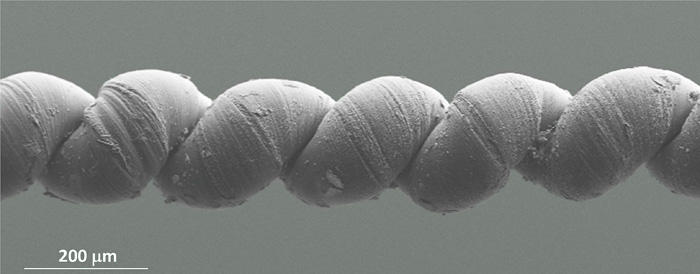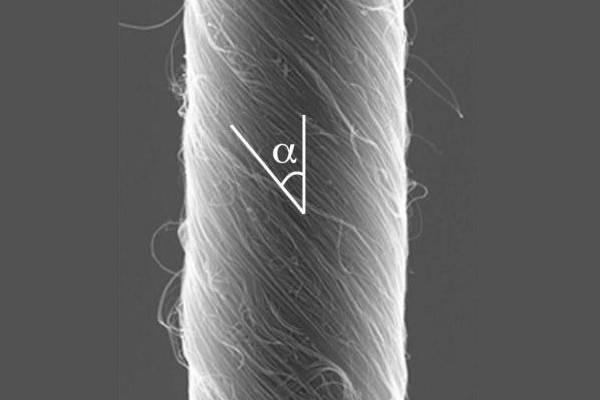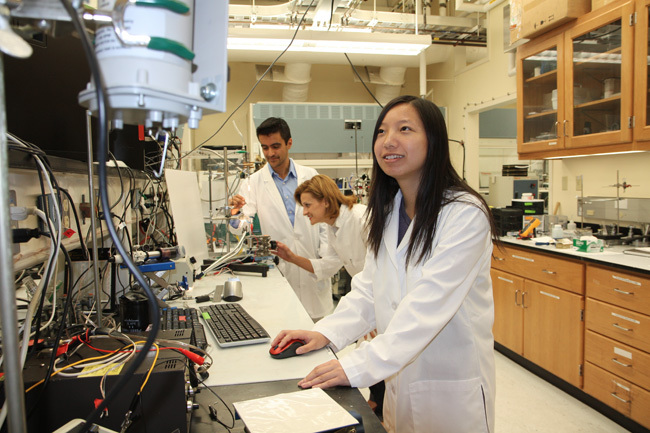It looks like you're using an Ad Blocker.
Please white-list or disable AboveTopSecret.com in your ad-blocking tool.
Thank you.
Some features of ATS will be disabled while you continue to use an ad-blocker.
4
share:
Hi all
Well i have to say this is pretty impressive..!


Technology never ceases to amaze me.. Sometimes it seems to be developing at such a rate that it kinda scares me. But this is good.
And maybe at some point in the foreseeable future, these 'nano muscles' may even replace human muscles. For example people with MD, MS and ME can have there damaged and/or wasted muscles replaced..
Also these new 'nano muscles' seem to be of use for many things...

www.kurzweilai.net...
I think the guys and ladies who managed to make these 'nano muscles' should give themselves a well deserved pat on the back..! And maybe even a drink or two
peace fluffx
Well i have to say this is pretty impressive..!
New artificial muscles made from nanotech yarns and infused with paraffin wax can lift more than 100,000 times their own weight and generate 85 times more mechanical power than the same size natural muscle, according to scientists at The University of Texas at Dallas and their international team from Australia, China, South Korea, Canada and Brazil.

The artificial muscles are yarns constructed from carbon nanotubes, which are seamless, hollow cylinders made from the same type of graphite layers found in the core of ordinary pencils.
Individual nanotubes can be 10,000 times smaller than the diameter of a human hair, yet pound-for-pound, 100 times stronger than steel.

Technology never ceases to amaze me.. Sometimes it seems to be developing at such a rate that it kinda scares me. But this is good.
And maybe at some point in the foreseeable future, these 'nano muscles' may even replace human muscles. For example people with MD, MS and ME can have there damaged and/or wasted muscles replaced..
Also these new 'nano muscles' seem to be of use for many things...
“Because of their simplicity and high performance, these yarn muscles could be used for such diverse applications as robots, catheters for minimally invasive surgery, micromotors, mixers for microfluidic circuits, tunable optical systems, microvalves, positioners and even toys,” Baughman said.

www.kurzweilai.net...
I think the guys and ladies who managed to make these 'nano muscles' should give themselves a well deserved pat on the back..! And maybe even a drink or two
peace fluffx
Wow, reminds me of the show The bionic man ( showing my age here)
I can see weight lifter addicts doing this as an elective surgery!
I can see weight lifter addicts doing this as an elective surgery!
reply to post by amatrine
LOL..!!
I doubt that the weight lifters will be allowed to cheat like that..! What makes me smile about this is that maybe soon in the future they will be able to use these 'nano muscles' to give disabled people a new lease of life...! Depending of course on their disability..
Like my cousin has cerebral palsy and cannot walk... maybe if these muscles were put into her it might give her the ability to walk again..!! We shall see - but that would make my day, week, month, year and life..!
LOL..!!
I doubt that the weight lifters will be allowed to cheat like that..! What makes me smile about this is that maybe soon in the future they will be able to use these 'nano muscles' to give disabled people a new lease of life...! Depending of course on their disability..
Like my cousin has cerebral palsy and cannot walk... maybe if these muscles were put into her it might give her the ability to walk again..!! We shall see - but that would make my day, week, month, year and life..!
Originally posted by fluff007
I doubt that the weight lifters will be allowed to cheat like that..! What makes me smile about this is that maybe soon in the future they will be able to use these 'nano muscles' to give disabled people a new lease of life...! Depending of course on their disability..
I also doubt they'd be allowed to cheat like that, but it does bring up a third variation on the Olympics. The Enhanced Olympics!! How far can you push the limits of the human body while allowing any alterations, enhancements and other stuff. The only rule there should be that it has to be something integral, or at least not an "add-on". A prosthesis has to be a replacement for an actual part. Any chemicals need to be produced in-body by integrated components.
Those will be some interesting games, when they happen.
reply to post by fluff007
Op source
Can't wait to see tebaplicatins developed for this new material. I could see a solar panel where the acuation not only spins a generator but flips a shade allowing the cycle
The remarkable performance of our yarn muscle and our present ability to fabricate kilometer-length yarns suggest the feasibility of early commercialization as small actuators comprising centimeter-scale yarn length,” Baughman said. “The more difficult challenge is in upscaling our single-yarn actuators to large actuators in which hundreds or thousands of individual yarn muscles operate in parallel
Op source
Can't wait to see tebaplicatins developed for this new material. I could see a solar panel where the acuation not only spins a generator but flips a shade allowing the cycle
This is awesome news.
To bad though that the tech will most likely in first hand be used to create super soldiers and kill people.
Yea sure, good ideas on paper, as long as no "big corporation" discretely buys the patents, and put the lid on it for their own research (war purposes)
To bad though that the tech will most likely in first hand be used to create super soldiers and kill people.
“Because of their simplicity and high performance, these yarn muscles could be used for such diverse applications as robots, catheters for minimally invasive surgery, micromotors, mixers for microfluidic circuits, tunable optical systems, microvalves, positioners and even toys,” Baughman said.
Yea sure, good ideas on paper, as long as no "big corporation" discretely buys the patents, and put the lid on it for their own research (war purposes)
edit on 19-11-2012 by LiberalSceptic because: (no reason given)
reply to post by LiberalSceptic
yeah thats the sad thing about it.. it could be used for such great things, but then again its already in the wrong hands... :/
yeah thats the sad thing about it.. it could be used for such great things, but then again its already in the wrong hands... :/
reply to post by fluff007
I do admit that I feel like a negative sauerkraut for thinking like this, but well, thats how it usually is/ends up.
I do admit that I feel like a negative sauerkraut for thinking like this, but well, thats how it usually is/ends up.
edit on 19-11-2012 by
LiberalSceptic because: (no reason given)
reply to post by LiberalSceptic
hey man dont worry about it... we need to understand and know how things really are. and yep they will no doubt use this for wrong doings, but they can also use it for good too. and hey, isn't it better to choose not to live in ignorance..?!
we need to know the truth, whether we like that truth or not..
hey man dont worry about it... we need to understand and know how things really are. and yep they will no doubt use this for wrong doings, but they can also use it for good too. and hey, isn't it better to choose not to live in ignorance..?!
we need to know the truth, whether we like that truth or not..
edit on 19-11-2012 by fluff007 because: (no reason given)
reply to post by fluff007
Heard the Japanese are planning on using nanotubes to build an elevator to the moon.. I am sure in time to come they will find many uses for this nanotech
Heard the Japanese are planning on using nanotubes to build an elevator to the moon.. I am sure in time to come they will find many uses for this nanotech
reply to post by purplemer
I could see an elevator to space... but there could be some interesting issues with an elevator all the way to the moon... since it is not in a geosync orbit. Though there could be something tethered on the moon-side and coming a significant portion of the distance to earth... just to avoid thrust, or need to control beyond hooking up to the towing system. Earth's gravity could maybe hold it in the right location?
Hmm. Interesting.
I could see an elevator to space... but there could be some interesting issues with an elevator all the way to the moon... since it is not in a geosync orbit. Though there could be something tethered on the moon-side and coming a significant portion of the distance to earth... just to avoid thrust, or need to control beyond hooking up to the towing system. Earth's gravity could maybe hold it in the right location?
Hmm. Interesting.
new topics
-
Merry Christmas !!
General Chit Chat: 2 hours ago
top topics
-
University looking for gender diverse kids to play with transgender dolls for research
Social Issues and Civil Unrest: 17 hours ago, 9 flags -
This is an interesting picture. Do we actually pick our leaders?
Politicians & People: 13 hours ago, 9 flags -
Trump says ownership of Greenland 'is an absolute necessity'
Other Current Events: 16 hours ago, 8 flags -
U.S. Govt Agencies That Protect Criminals in Government - National Archives Records Admin-NARA.
Political Conspiracies: 14 hours ago, 6 flags -
FAA Investigates Christmas Drone Show Gone Wrong in Orlando, FL 12/2024
Other Current Events: 17 hours ago, 5 flags -
An Updated China Navy Analysis and the Challenges of their AI/Drone Development
Military Projects: 17 hours ago, 4 flags -
Merry Christmas !!
General Chit Chat: 2 hours ago, 2 flags
active topics
-
Australian mercenary caught and crying as he is a prisoner of war.
Other Current Events • 44 • : Flyingclaydisk -
U.S. Govt Agencies That Protect Criminals in Government - National Archives Records Admin-NARA.
Political Conspiracies • 7 • : ElitePlebeian2 -
Panamanian President-“every square meter” of the Panama Canal belongs to Panama.
New World Order • 37 • : Xtrozero -
Why isn't Psychiatry involved?
Social Issues and Civil Unrest • 36 • : Xtrozero -
Merry Christmas !!
General Chit Chat • 2 • : TNMockingbird -
The Shed 26
General Chit Chat • 841 • : TNMockingbird -
Biden Nationalizes Another 50,000+ Student Loans as He Heads for the Exit
US Political Madness • 22 • : 38181 -
This is an interesting picture. Do we actually pick our leaders?
Politicians & People • 8 • : UpIsNowDown2 -
Spiritual Solstice
Short Stories • 16 • : Naftalin -
California Business Owners Blindsided by Surprise Payroll Taxes
US Political Madness • 15 • : Dalamax
4
